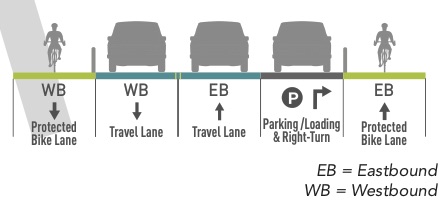
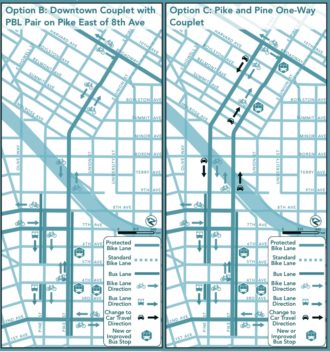
Pike/Pine is one of the most needed and promising connections in the entire Seattle bike network. And the multi-agency One Center City partnership is looking to make major near-term changes along the corridor between Pike Place Market and Broadway that include protected bike lanes.
We already wrote about the One Center City ideas for north-south streets downtown, so this post will focus on the Pike/Pine elements. You can give feedback on the entire plan via this online open house.
Not only are Pike and Pine packed with destinations (video), they also provide the most bike-friendly climbs between downtown and huge swaths of densely-packed Capitol Hill and Central District neighborhoods.
But between playing leap frog with buses and dodging parking or turning cars and deliveries, biking these streets today often feels like completing an obstacle course. And unfortunately, not everyone makes it. Police data shows 15 collisions involving someone on a bike and 23 involving people walking on Pike and Pine between 1st Ave and Broadway in 2016 alone (many more likely went unreported).
So what can be done to make these streets work better? Well, lets start with a few priorities:
- Walking safety upgrades are long overdue. Many crosswalks on both streets need serious fixes. Walking is by far the dominant way people get around in the Pike/Pine corridor, and the streets should reflect that. Instead, many crosswalks feel very scary, and nearly every intersection has a history of serious collisions.
- Biking safety and connectivity in the Pike/Pine corridor is one of the best investments the city can make if it is serious about increasing the number of people biking around town. This key link will actualize years of investments in central Seattle biking, including the Broadway Bikeway, by connecting those investments to downtown jobs and destinations. It will also do wonders for further activating the 2nd Ave bike lane and will complete future connections to the north via 7th/8th Avenues.
- Bus efficiency is of course a major use, both for neighborhood routes heading up the Hill and regional routes that access the I-5 Express Lanes at Pike/9th Ave. This Express Lane connection will become even more important for more routes once buses are kicked out of the transit tunnel in 2018.
- Perhaps more than any other business district in the city, Pike/Pine businesses thrive in a truly multimodal environment. This is a great part of what makes the neighborhood the way it is. Friendlier streets that are more comfortable for hanging out and getting around on foot will further support the business district. It’s also an environment eager to experiment with more out-of-the-box ideas for how streets function, as shown by the area’s car-free nights.
With these priorities in mind, the One Center City’s existing plans have some good starts. The team recently released two new concepts. Option A is the “no change” option, so we’ll skip it.
Option B would add protected bike lanes on Pike, but delete the existing paint-only bike lanes from Pine. Downtown, people biking westbound would move to Pine Street, and eastbound people would have to switch from the left side of the street to the right:
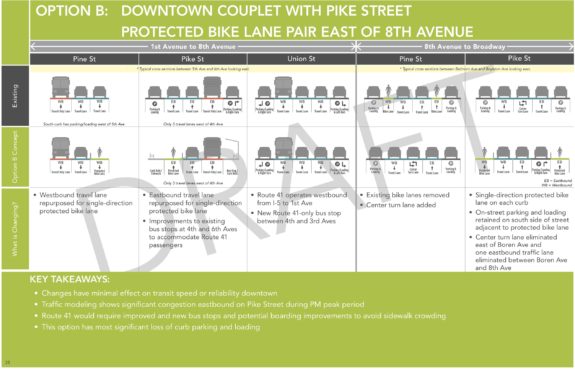 Option C would turn Pike and Pine into a couplet of one-way streets with continual one-way bike lanes the whole way:
Option C would turn Pike and Pine into a couplet of one-way streets with continual one-way bike lanes the whole way:
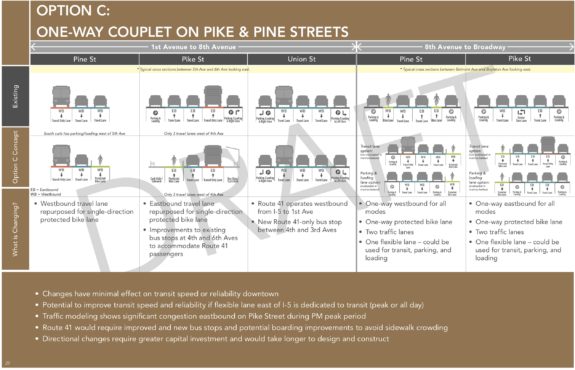 Neither of these concepts is perfect. While the bike lanes are perhaps more continuous in Option C, that option’s plan to have two general purpose lanes traveling in the same direction could be horrible for walkability and safety for all users (more on this below).
Neither of these concepts is perfect. While the bike lanes are perhaps more continuous in Option C, that option’s plan to have two general purpose lanes traveling in the same direction could be horrible for walkability and safety for all users (more on this below).

But there are some good starting points here, especially for short-term changes. Much more comprehensive changes are likely in the corridor’s future in the mid-term thanks to the Pike Pine Renaissance project. But people need a safe bike connection as soon as possible, even if it is a temporary solution. Because the status quo is terrible.
Downtown

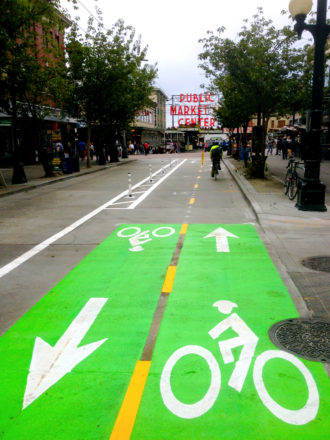
West of 8th Ave or so, Options B and C are pretty much the same. Pike and Pine are already one-way couplets, and the plan would add one-way protected bike lanes on the left side of each street (the bike lane on Pine would disappear for the brick-paved section at Westlake Park).
Especially for Option B, the transition around 8th Ave is the sticking point. It will need to be very well-designed to avoid significant bike delays and confusion as the westbound lane moves to Pine and the eastbound lane switches sides of the street.
Neither option includes a continuation of the existing two-way bike lane on Pike Street between 1st and 2nd, which is a bit surprising. Simply extending the existing lane to 8th Ave seems like the easiest solution, since it would more easily connect to the Option B bike lanes on Pike up to Capitol Hill. It also provides a much better connection from Pike Place Market, since Pine Street is much, much steeper for people leaving the Market.
Capitol Hill
For what we’ll call the Capitol Hill section (east of 8th Ave or so), Option B is very solid set of improvements that could happen quickly. Few significant street changes would be needed, and the trolley bus wires wouldn’t need to move. Much of the work could be done using paint and plastic posts.
But there is no need to delete the existing Pine Street bike lanes in Option B, which will still be needed for local access to businesses and for their traffic calming benefit. Traffic volume data shows Pike and Pine carrying nearly identical numbers of vehicles daily, with Pine carrying about 2,000 more per day (many of which are people biking). Pine could use safety improvements, but deleting the bike lanes would be a step in the wrong direction.
A multi-lane Pike/Pine could be terrible for safety
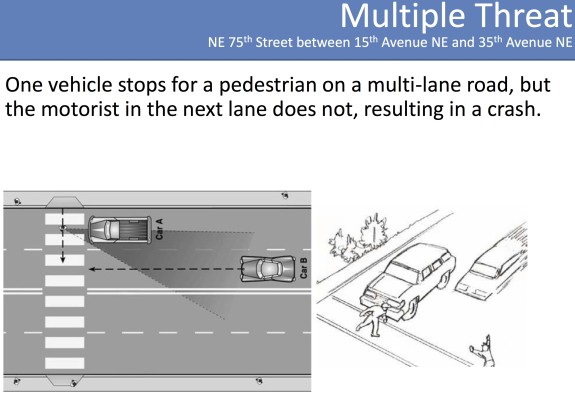
Having two lanes in the same direction, as Option C proposes, increases serious collisions for all road users by creating a multi-lane threat we are all familiar with: One driver stops to let someone cross, but the driver in the adjacent lane keeps going full speed. Not only is this a deadly scenario for people walking and biking, but it also leads to t-bone crashes between people driving, which are among the most deadly kinds of car crashes.
Multi-lane streets also encourage speeding by allowing the fastest driver to set the pace of traffic rather than the slowest. The city’s most successful road safety projects, from NE 75th Street to Rainier Ave, have focused on reducing this problem.
Option C would be similar to the Roosevelt/11th Ave couplet in the U District, which is not nearly as friendly and inviting as Pike and Pine are today. That’s not a great vision for the future of Pike and Pine.
“Option D”
If we combine some of the feedback above into a new option, “Option D” would extend the two-way protected bike lane on the north side of Pike from where it ends at 2nd Ave to 8th Ave or so, where it would meet with the Option B plan above. Somewhere between 8th Ave and Bellevue Ave, the eastbound bike lane would split and cross to south side of the street. The westbound bike lane on Pike would continue straight from Broadway to Pike Place Market.
Pine could definitely use some work, but the city could leave it as it is and still meet the short-term goals of keeping buses moving and creating a safe bike connection. Of course we would love a big safe streets remake of Pine, but it would be unwise to delete the existing bike lanes to try to squeeze a turn lane onto the street.
La Rambla on Pike/Pine?
While we’re talking about changes to Pike and Pine, we should also think about some more “out there” ideas. This is inspired by an idea posted by Capitol Hill Seattle seven years ago: The Pike Rambla.
To riff off the Option C one-way couplet idea, what if there were only one general purpose lane on each street? That would open up some very interesting options for increasing public space and truly prioritizing a vibrant street life.
In my head, the Rambla starts around Bellevue Ave (where the buses turn off Pike) and goes to 12th Ave, though other start and end points may make sense. Here’s what the before and after could look like, made using Streetmix (Pike, Pine):
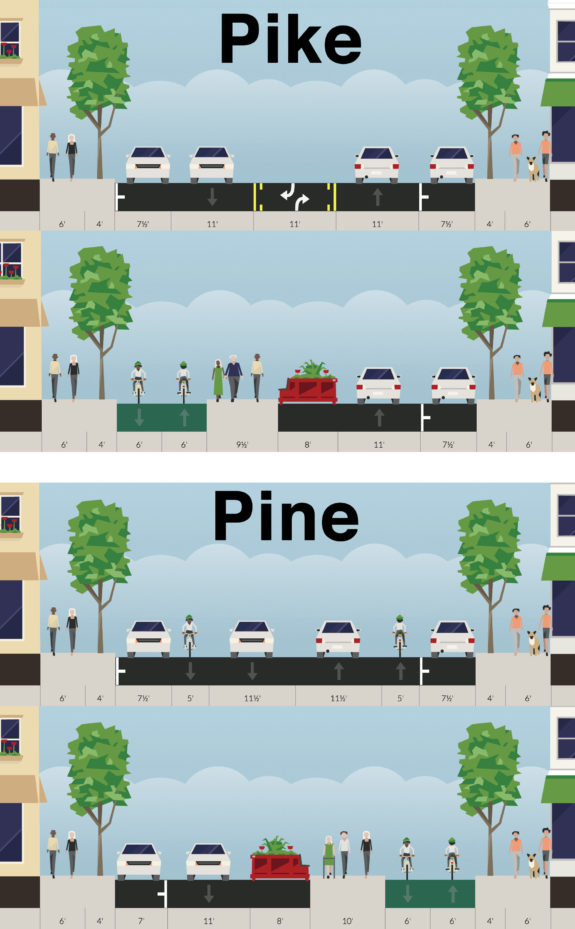 The flex space with the parklet in the image could also be used for more on-street parking or loading zones and still leave a good amount of new public space. This could be great market space, with opportunities for small businesses, restaurant service, events, park space and more in the middle of the street. I have no idea how this would affect bus service, but I’m guessing it would slow them down.
The flex space with the parklet in the image could also be used for more on-street parking or loading zones and still leave a good amount of new public space. This could be great market space, with opportunities for small businesses, restaurant service, events, park space and more in the middle of the street. I have no idea how this would affect bus service, but I’m guessing it would slow them down.
Alternatively, you could leave Pine the way it is and only implement the Rambla idea on Pike. In that scenario, perhaps the city would build a two-way bike lane on Pike from 1st to Broadway (at least). That would provide a continuous bike connection and have less of an impact on buses.
And if the city uses paint, flower planters and folding chairs, a pilot version of this idea could happen quickly and for relatively little cost.
Do you have an idea for Pike and Pine? Let us know in the comments!








Comments
7 responses to “How One Center City can finally build the vital Pike/Pine bike connection”
I’m actually open to removing the bike lanes on Pine Street if we get a safe route on Pike Street in Capitol Hill. Between Melrose and Broadway, Pine Street is quite dangerous for riders because you ride in the parked car door zone and you have to leapfrog with multiple buses at transit stops. And then the lanes completely disappear at I-5, which creates a dangerous condition where you are forced to merge with cars – we shouldn’t ever encourage that kind of design.
For option B is there a reason they couldn’t keep the one way bike lanes on Pike/Pine and not convert the streets to one ways on Capitol Hill?
The ultimate goal has to be to slow down vehicle traffic. For all the reasons described in the article, these need to be thought of as neighborhood streets dominated by pedestrian traffic, not slow speed freeways. Cars should think of them as destinations, and use alternate routes to get to other destinations.
Of course, I feel the same way about downtown’s north-south streets.
The unfortunate thing about a lot of these designs on sloping streets is that they treat uphill and downhill the same, but we all know that a bike is a very different vehicle downhill at 20 mph than uphill at 4 mph. A more thoughtful design would be better about accounting for the vastly different speeds.
Anyway, our prosperous mayor really couldn’t care less about the bike-riding scrum, so I’m not holding my breath for any changes until he is tossed out of office – which doesn’t seem likely to happen anytime soon.
Great post, Tom. You’re right on target about the traffic speed issues in Option B! I favor your Option D (assuming La Rambla wouldn’t be palatable to the mayor or SDOT right now).
[…] Bike riders might be particularly interested in the concepts being floated for protected bike lanes on Pike and Pine: […]
Just rode home from downtown to the hill at rush hour. The status quo is indeed unworkable. Who do i contact to advocate for one of these options?